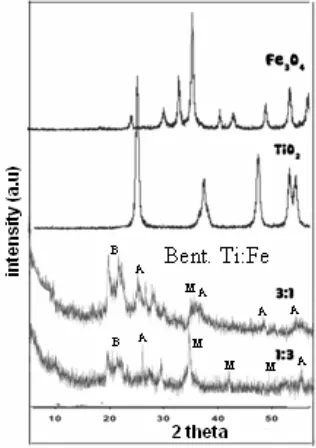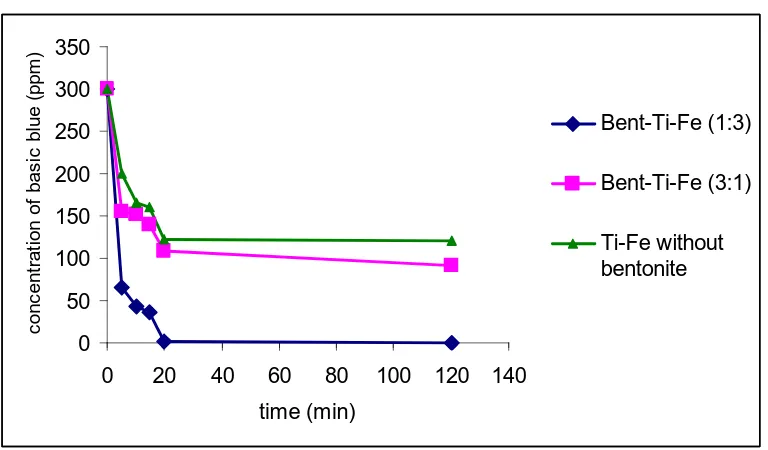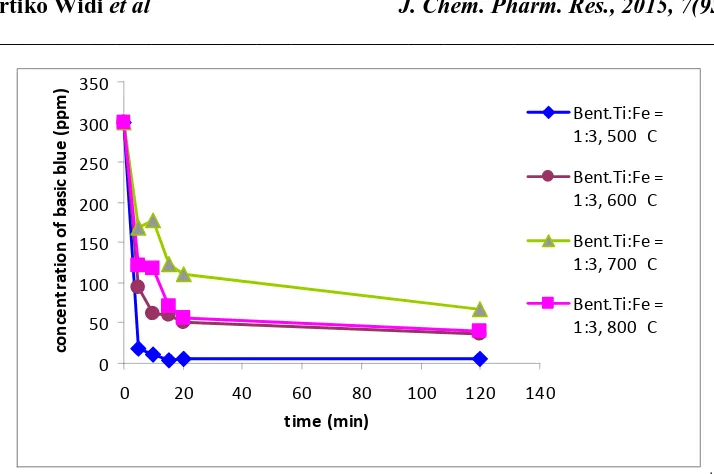Journal of Chemical and Pharmaceutical Research, 2015, 7(9S):183-188
Research Article
ISSN : 0975-7384
CODEN(USA) : JCPRC5
Use of TiO
2-Fe
3O
4pillared bentonite as photocatalyst in photodegradation of
basic blue
Restu Kartiko Widi
*, Arief Budhyantoro
and Emma Savitri
Department of Chemical Engineering, University of Surabaya (UBAYA), Raya Kalirungkut Tenggilis TG building 5th floor, Surabaya, Indonesia
_____________________________________________________________________________________________
ABSTRACT
Surfactant molecule pillared bentonite was prepared and used as porous support for synthesis of TiO2-Fe3O4 based
photocatalyst with varying TiO2 and Fe3O4 loading. The raw bentonite was obtained from Pacitan, Indonesia. The
kind of surfactants which used on this research was Tetra Methyl Ammonium salt. The loading variations of TiO2
-Fe3O4 in this experiment were 1:3 and 3:1. The synthesis of the photocatalytic materials have been carried out by
sol-gel method and followed by calcination. The temperature of calcination was at 500, 600, 700 and 800oC. The physicochemical properties of TiO2-Fe3O4 bentonite samples were characterized by X-ray diffraction.
Photocatalytic activity of the materials was evaluated by basic blue photo degradation using UV light. The titania and magnetite content in the materials significantly influenced the physicochemical properties and catalytic activity. Optimum TiO2 and Fe3O4 loading in the material produced crystalline of anatase and magnetite furthermore
enhanced basic blue degradation.
Keywords: TiO2, Fe3O4, bentonite, photocatalytic, basic blue degradation
_____________________________________________________________________________________________
INTRODUCTION
It is well known that the dye effluents, which may be from dyestuff manufacturing and textile industries, may exhibit toxic effects on microbial populations and can be toxic and/or carcinogenic to mammalian animal [1].
Because of their resistance to degradation, they might be present on wastewater at substantial quantity. Though not particularly toxic, dyes might be harmful to human beings and hazardous to aquatic organisms; not to mention their adverse aesthetic effects as they are quite visible. The presence of color also reduces aquatic diversity by blocking the passage of light through water [2].
Various measures have been developed against sources of air, water and soil pollution and have proven effective to a certain degree. However, there are still some unsolved problems with regards to air pollution and yet other new problems such as hazardous chemical substances have arisen. In addition to developing economically feasible measures for energy and resource conservation that are applicable to small to medium size sources of pollution, it is necessary to develop technology to directly clean polluted environments (environmental purification technology). A photocatalyst can break down and remove a variety of environmental (load) pollutants at room temperature by oxidation, using sunlight or artificial light as an energy source.
Nowadays, photocatalytic degradation of organic contaminants is attracting extensive interest for their potential
As a semiconductor with wide band gap energy and nontoxicity, it is widely used for photocatalytic decomposition of various organic compounds in wastewater treatment [8-10]. However, the use of titania in bulk form suffers from catalyst recovery and activity reduction, which results in ineffective application of the catalyst. In some cases, fine titania particles could also block the penetration of light into the solution. To overcome the limitations, several
approaches were proposed e.g. by optimizing the nanostructure of TiO2, using various processing routes, such as a
sol-gel method [11] and hydrothermal processing [12]. The photocatalytic activity can also be altered by doping
with a transition metal oxide such as ZrO2 [13], WO3 [14], F3O4 [15], etc.; the addition of metal or metal oxide
enhances the thermal stability of the anatase phase, and increases the surface area and surface acidity, resulting in improved photocatalytic activity [13].
The other approach was also reported, i.e. attaching titania particles onto stable inorganic supports [14, 15]. In principle, inorganic materials with high specific surface area and chemical stability can be used as host matrix. Natural porous materials such as zeolites and clay minerals are also good and cheaper supports with eco-friendly properties.
Bentonite as a clay minerals own high porosity, exchangeable cations and swellable properties. Previously, some researchers reported that during the preparation of titania immobilization on clay minerals via pillarization processes, titania was incorporated in the interlayer space of the clay through an intercalation step of pillaring precursors via ionic species. The process was followed by calcination to convert the titanium hydroxide to oxide. However, highly acidic environment of titanium pillaring precursor damages the structure of clay minerals [16,17]. As a result, the low crystallinity of supported titania would have a reduced activity in heterogeneous catalysis. In addition, the preparation was not reproducible [18]. Recently, some investigations reported the synthesis of
supported TiO2 or TiO2 composites as catalysts [19-25].
In this paper, we report preparation of pillared Indonesian Bentonite and its use as a support for Fe3O4-doped TiO2
immobilization. These photocatalyst were characterized by X Ray Diffraction and tested for photodegradation of basic blue.
EXPERIMENTAL SECTION
The starting clay was a natural Pacitan bentonite, extracted from Pacitan region, East Java, Indonesia. Initially, as-collected bentonite was dried in forced-circulation oven at 110 °C to remove excess moisture content. The drying process was carried out for 24 h. Subsequently, dried bentonite was crushed to obtain powder bentonite with a
particle size of 60/80 mesh. The preparation of TiO2-Fe3O4 based photocatalyst was based on modification of
Massart method by sol-gel method. The material was prepared by mixing colloidal Ti (from TiCl4, Merck) and
colloidal Fe (from FeCl2 and FeCl3, Merck) which has molar ratio of 1:3 and 3:1. Immobilization process was
carried out by mixing this colloid with bentonite suspension. The mixture was heated at 50oC. After 24 hours, the
mixture was cooled and washed with aquadest. The obtained solid was dried and calcined at 500, 600, 700, and
800oC for 4 hours with nitrogen and oxygen stream. All the materials were systematically characterized by powder
X-ray diffraction (Shimadzu XRD 1000).
The catalytic performance of catalyst materials was carried out in a batch glass reactor equipped with thermometer for photocatalytic degradation of basic blue. It was open to the atmosphere and thoroughly stirring with magnetic
stirrer. The reaction was conducted at 30oC for 120 minutes. The initial molar ratio of basic blue was 300 ppm; the
weight of catalyst was 0.25 g. Irradiation was carried out by keeping the whole assembly exposed to a 100 W mercury lamp. The course of the basic blue degradation was followed by uv-vis spectrophotometer means of Genesis 10. Conversion is defined as the ratio of consumed basic blue over the fed basic blue for the reaction.
low. Additionally, the (101) reflection of rutile at 27° was found. Titania crystallization at high loading was also observed in the preparation of nanoparticle titania membranes and titania incorporation in gels reported in previous studies, where both anatase and rutile forms were produced. In the pillared bentonite anatase was generally formed
or sometimes no reflections of titania were found [24, 26-28]. The hydrolysis rate of TiCl4 may affect the titania and
crystallization in the bentonite. Titanium and Fe would be fast deposited in gel form before it reached the bentonite
pores [24]. Due to the gel form with larger molecular size, TiCl4 were difficult to penetrate into the pores of
bentonite and the condition would favor the formation of both anatase and rutile during the crystallization process. Figure 1 also shows that intensity of tetragonal titania (anatase) in Bent-Ti:Fe (3:1) is higher than the intensity of magnetite compare to that of in Bent- Ti:Fe (1:3). This is due to higher loading of titania in Bent-Ti:Fe (3:1).
Figure 1. XRD difractogram of bentonite TiO2-Fe3O4 in ratio molar variation
The calcinations temperature may affect the titania and magnetite crystallization in the bentonite. At high calcinations temperature, titanium would be fast deposited in gel form before it reached the montmorillonite [29]. Due to the gel form with larger molecular size, titanium was difficult to penetrate into the pores of montmorillonite and the condition would favor the formation of both anatase and rutile during the crystallization process (Fig. 2).
Photodegradation of basic blue
The photocatalytic degradation of basic blue was observed at λmax = 600 nm. The results of a typical run are
graphically represented in Fig. 3 and Fig.4.
In Fig. 3 it was observed that with an increase in titania loading in the catalyst material, the capability of photocatalytic degradation of the dye decreases. This behavior can be explained on the basis that as the titania loading increases, more rutile phase are available rather than that of anatase phase (Fig. 1). This is probably due to
the textural change and surface distribution of TiO2. Loading of TiO2 reduced the specific surface area, which
resulted in low adsorption of basic blue on catalyst surface for the basic blue to be contacted with TiO2 anatase for
reaction. In addition, the aggregation of TiO2 in Bent-Ti-Fe (3:1) might also reduce its dispersion on bentonite,
Figure 2. XRD difractogram of bentonite TiO2-Fe3O4 (1:3) in different calcinations temperature
Figure 3. Effect of titania loading in catalyst on the activity of photocatalytic degradation of basic blue
The effect of variation of calcinations temperature of catalysts was also studied by taking different temperature from
500 – 800oC. The result is graphically presented in Fig. 4. From the data presented in fig.4, it is clear that the activity
0
Figure 4. Effect of calcinations temperature of catalysts on the rate of photocatalytic degradation of basic blue
CONCLUSION
The photocatalytic decolourization of basic blue over TiO2-Fe3O4 pillared bentonite provides an ecofriendly method
for degradation of the dye. The titania and magnetite content in the materials significantly influenced the physicochemical properties and catalytic activity. In addition, the calcinations temperature of the catalysts affect in the material produced in crystalline of anatase and magnetite furthermore enhanced basic blue degradation.
Acknowledgements
The authors would like to express sincere gratitude to the Ministry of Research, Technology and Higher Education, Republic of Indonesia through Hibah Penelitian Unggulan Perguruan Tinggi, 2015 for the financial support to this research.
REFERENCES
[1] J.F. Lemonas, Am. Ceram. Soc. Bull., 1997, 76, pp. 92–95.
[2] Khenifi, A., Bouberka, Z., Sekrane, F., Kameche, M., Derriche, Z., Adsorption, 2007, 13 (2), 149–158. [3] H. Tong, S. Ouyang, Y. Bi, N. Umezawa, M. Oshikiri, J. Ye, Advanced Materials, 2012, 24, 229–251. [4] M. Xu, P.M. Da, H.Y. Wu, D.Y. Zhao, G.F. Zheng, Nano Letters, 2012, 12, 1503–1508.
[5] J.N. Schrauben, R. Hayoun, C.N. Valdez, M. Braten, L. Fridley, J.M. Mayer, Science, 2012, 336, 1298–1301. [6] W. Zhou, F.F. Sun, K. Pan, G.H. Tian, B.J. Jiang, Z.Y. Ren, C.G. Tian, H.G. Fu, Advanced Functional
Materials, 2011, 21, 1922–1930.
[7] G. Cernuto, N. Masciocchi, A. Cervellino, G.M. Colonna, A. Guagliardi, Journal of the American Chemical Society, 2011, 133, 3114–3119.
[8] Rajeshwar, K., Osugi, M.E., Chanmanee, W., Chenthamarakshan, C.R., Zanoni, Kajitvichyanukul, P., Krishnan-Ayera, R., J. Photochem. Photobiol., 2008, C. 9, 15–36.
[9] Fujishima, A., Zhang, X., Tryk, D.A., Int. J. Hyd. Ene., 2007, 32, 2664–2672. [10] Fujishima, A., Zhang, X., Tryk, D.A., Surf. Sci. Rep., 2008, 63, 515–582. [11] E. Pabón, J. Retuert, R. Quijada, J. Porous Mater., 2007, 14, 151–158.
[12] Yin, H. Ding, G, Gao, B, Huang. F, Xie, X., Jiang, M., Mater. Res. Bul., 2012, 47, 3124–3128. [13] Sakulkhaemaruethai, S., Kitiyanan, A., and Yoshikawa, S., J. Cer. Proc. Res., 2006, 7, 10-13. [14] Qureshi, U., Blackman, C., Hyett, G., and Parkin, I.P., Eur. J. Inorg. Chem., 2007, 10, 1415–1421. [15] Xu, J., Ao, Y., Fu, D., Yuan, C., J. Phys. Chem. Sol., 2008, 69, 1980–1984.
[16] Mahmoudi, N.M., Arami, M., J., Photochem. Photobiol., 2009, B. 94 (1), 20–24.
[18] Yuan, Peng, Yin, Xiaolin He, Hongping, Yang, Dan, Wang, Zhu, Linjiang, Jianxi,. Micro. Meso. Mat., 2006, 93 (1–3), 240–247.
[19] Bergaya, F., Theng, B.K.G., Lagaly, G., Handbook of Clay Science, Developments in Clay Science, 2006, Volume 1. Elsevier Science, Amsterdam.
[20] Romero, A., Dorado, F., Asencio, I., Garcia, P.B., Valverde, L., Clays Clay Miner. 2006, 54 (6), 737–747. [21] An, T.C., Chen, J.X., Li, G.Y., Ding, X.J., Sheng, G.Y., Fu, J.M., Mai, B.X., O'Shea, K.E.,. Catal. Today,
2008, 139, 69–76.
[22] Belessi, V., Lambropoulou, D., Konstantinou, I., Katsoulidis, A., Pomonis, P., Petridis, D., Albanis, T., J. Col.
Int. Sci., 2007, 322, 190–195.
[23] Menesi, J., Korosi, L., Bazso, E., Zollmer, V., Richardt, A., Dekany, I., Chemosphere, 2008, 70, 538–542. [24] Fatimah, I., Wang, S., Narsito, Wijaya, K., Appl. Clay Sci., 2010, 50, 588–593.
[25] Widi, R.K., Budhyantoro, A., Inter. J. Appl. Eng. Res., 2014, 9 (23), 18753-18758.
[26] Ding, X., An, T., Li, G., Zhang, S., Chen, J., Yuan, J., Zhao, H., Chen, H., Sheng, G., Fu, J., J. Col. Int.Sci,
2008, 320, 501–507.
[27] Rezala, H., Khalaf, H., Valverde, J., Romero, A., Molinari, A., Maldotti, A., Appl. Catal. A., 2009, 352, 234– 242
[28] Binitha, N.N., Sugunan, S., Micromeso., 2006, 93, 82–89.


